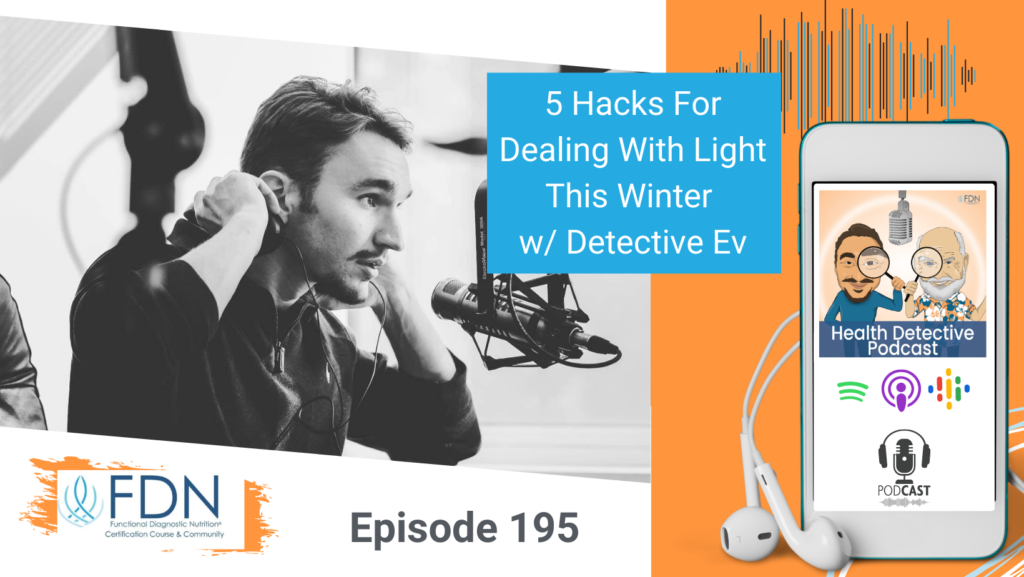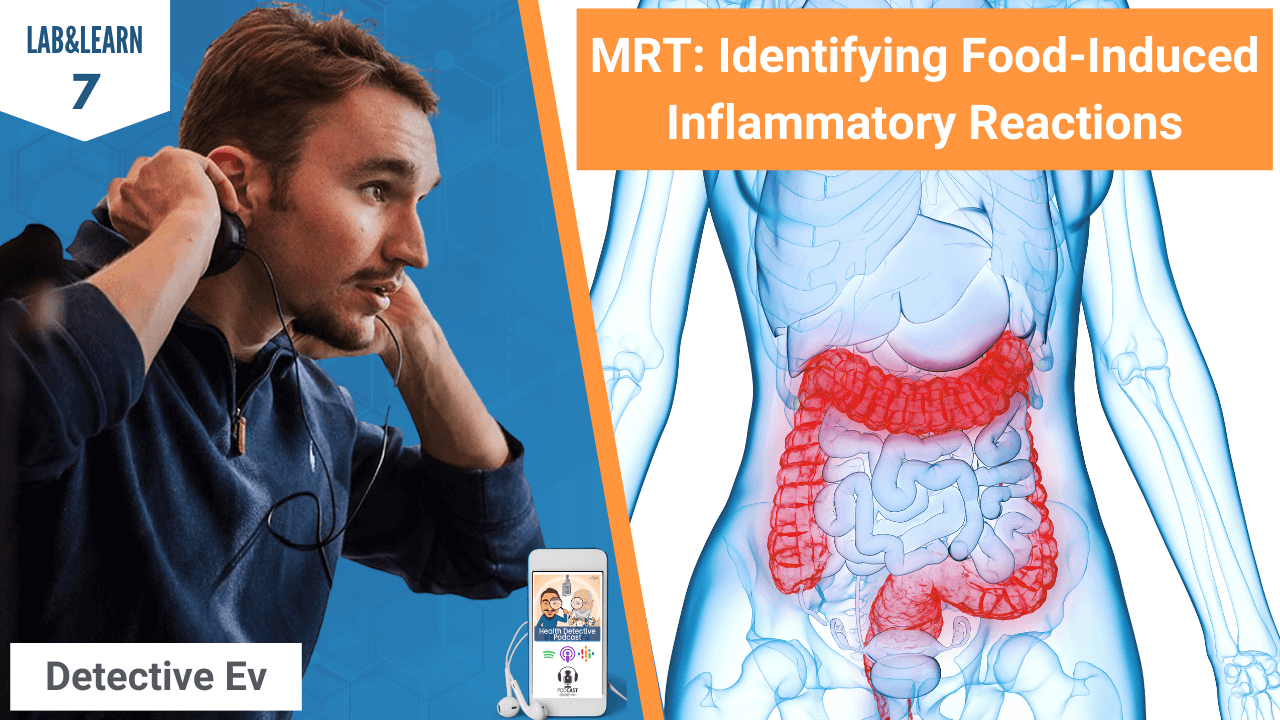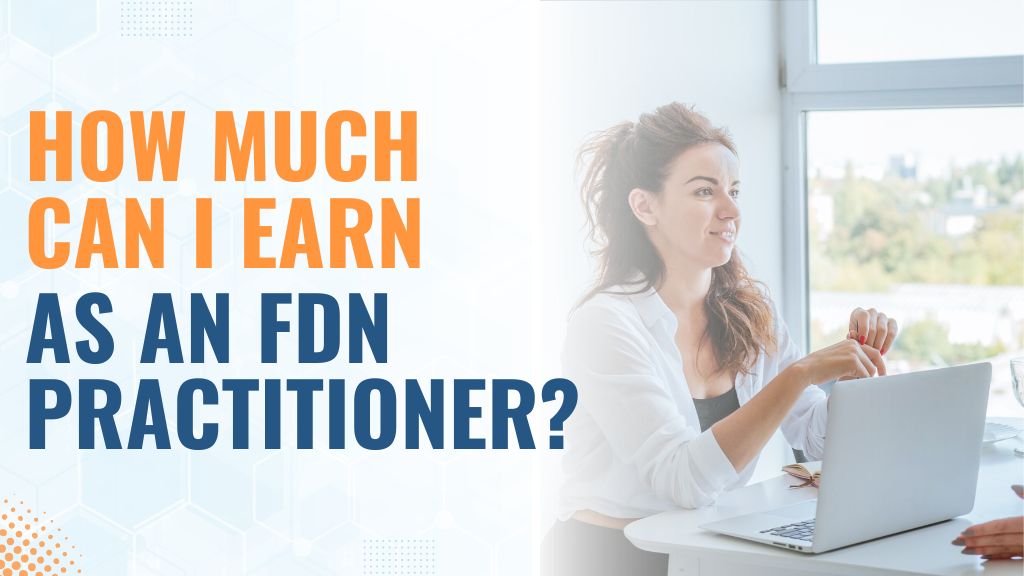Introduction
[00:00:00] Detective Ev: Well, hello my friends, and welcome back to another episode of the Health Detective Podcast by Functional Diagnostic Nutrition. My name is Evan Transue, aka Detective Ev. I will be your host for today’s show on dealing with light.
We are doing a short and sweet episode today. But it’s one that I love doing because I’ve done this before, around this time of year. It is one of my favorite passions, it’s all about light. And specifically today, how you can manage light and use it to your advantage during the winter season.
Now, first things first. I acknowledge that we have a worldwide audience and so not everyone is experiencing winter right now. I fully get that. But when I look at the analytics, I mean, we are US based for sure on this podcast with Canada being our second most listened to country. So, in those places we are coming up on the winter and experiencing at the very least a cold fall for sure. It’s definitely much colder here this time than it was last year. So, we need to know how to manage this.
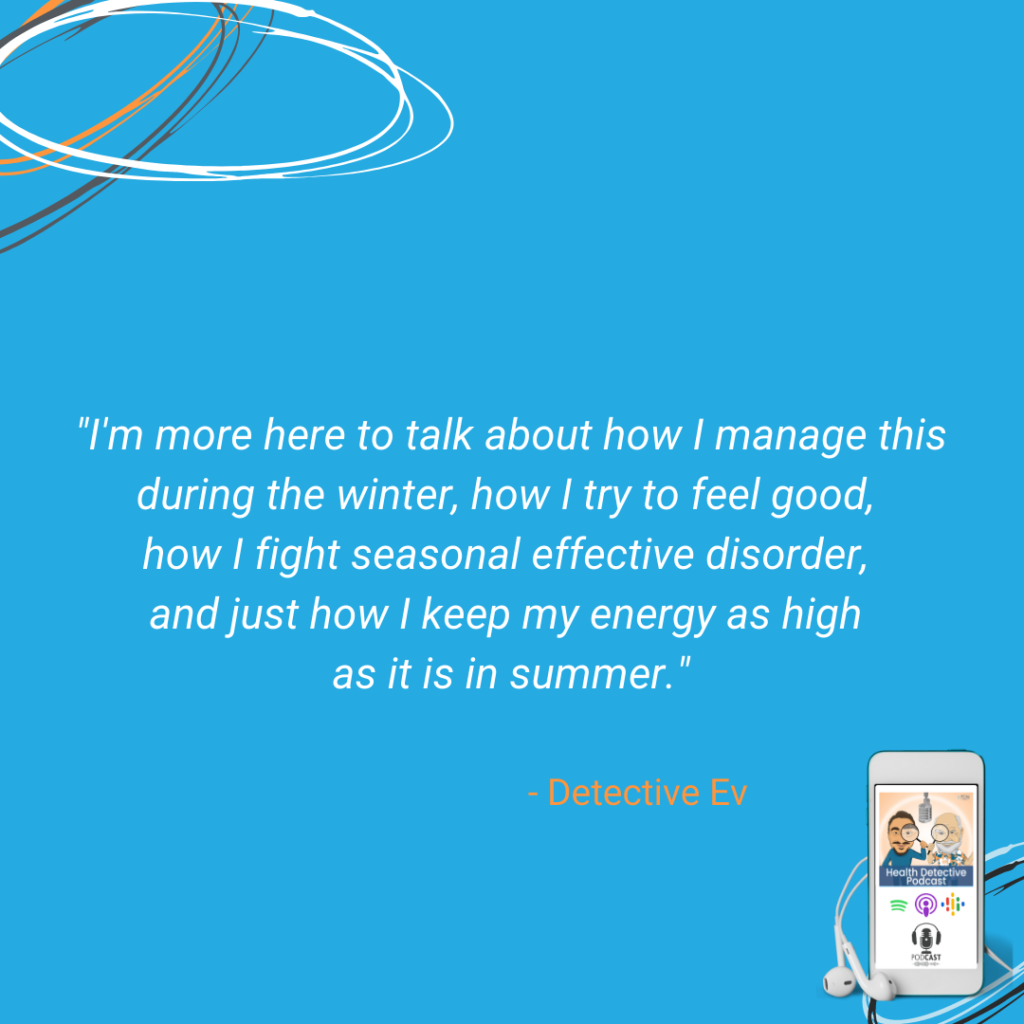
I’ve done episodes before where I’ve talked about the importance of light, and I’m sure that’ll naturally be sprinkled in today. But that’s not really what I’m here to sell you on. I’m more here to talk about how I manage this during the winter, how I try to feel good, how I fight seasonal effective disorder, and just how I keep my energy as high as it is in summer. I’m sure it’s not identical, but it’s pretty close to being up there. I’d like to be able to do that for you guys as well through what we’re going to talk about today.
Dealing with Light by Catching Sunrise
The first easy one, something I’ve discussed many times before is catching sunrise. Now, the sicker you are, the more this is probably going to have to be something that you’re quite compliant with. So, the sicker that you are, you’re definitely going to want to be out in the sunrise.
Of course, don’t be silly, if you’re healthy, you don’t want to take it for granted. But I’m the first one to admit, I do the speaking in schools, as many of you guys know, and a lot of these are early. Now, thankfully because of daylight savings, that actually helps me because it puts the sunrise back in like the 6:00 AM range instead of 7:00 AM. So, there’s always this couple week stretch during the year, which I really do not like because the sunrise might be at 7:30 AM.
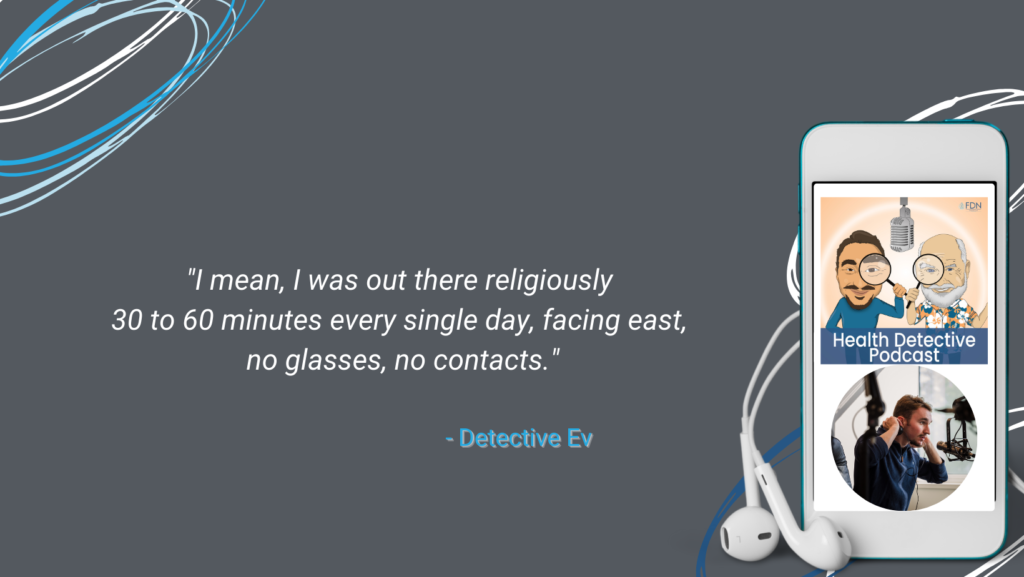
I might be starting to speak in the schools at 7:30 in the morning, even though I was driving there for maybe an hour or two, there was really nothing I could do to get light. I’m in an interesting position. I love my job, and I am also thankfully no longer sick enough to say, hey, I’m not going to sacrifice something that I know is a good idea for something that I love. I’m able to do that now, but when I was at my sickest, that isn’t something I was doing. I mean, I was out there religiously 30 to 60 minutes every single day, facing east, no glasses, no contacts.
Dealing with Light: Sunrise Hacks
You just walk around, figure out something else to do. If you like biking, that can be a good thing to do. Obviously, it’s winter, that might not be practical. We can always walk, just throw on a jacket.
It’s amazing to me how many people complain about it being cold. I’m like, do you know that there are people that hike places like Mount Everest? Do you know that there are jackets and hats and gloves that are designed for Arctic temperatures, like very, very cold places? I think you can find something to wear in your 20-degree weather.
I’m not saying it isn’t cold, I’m saying that there’s plenty of jackets out there that will keep you warm in that weather, and you can walk around and still be out in the morning.
So, you want to be even more compliant with that, again, the sicker that you are if you are feeling good. If you’re doing better, it’s still something that in a perfect world you would do every single day. But there’s kind of ways to hack this, right?
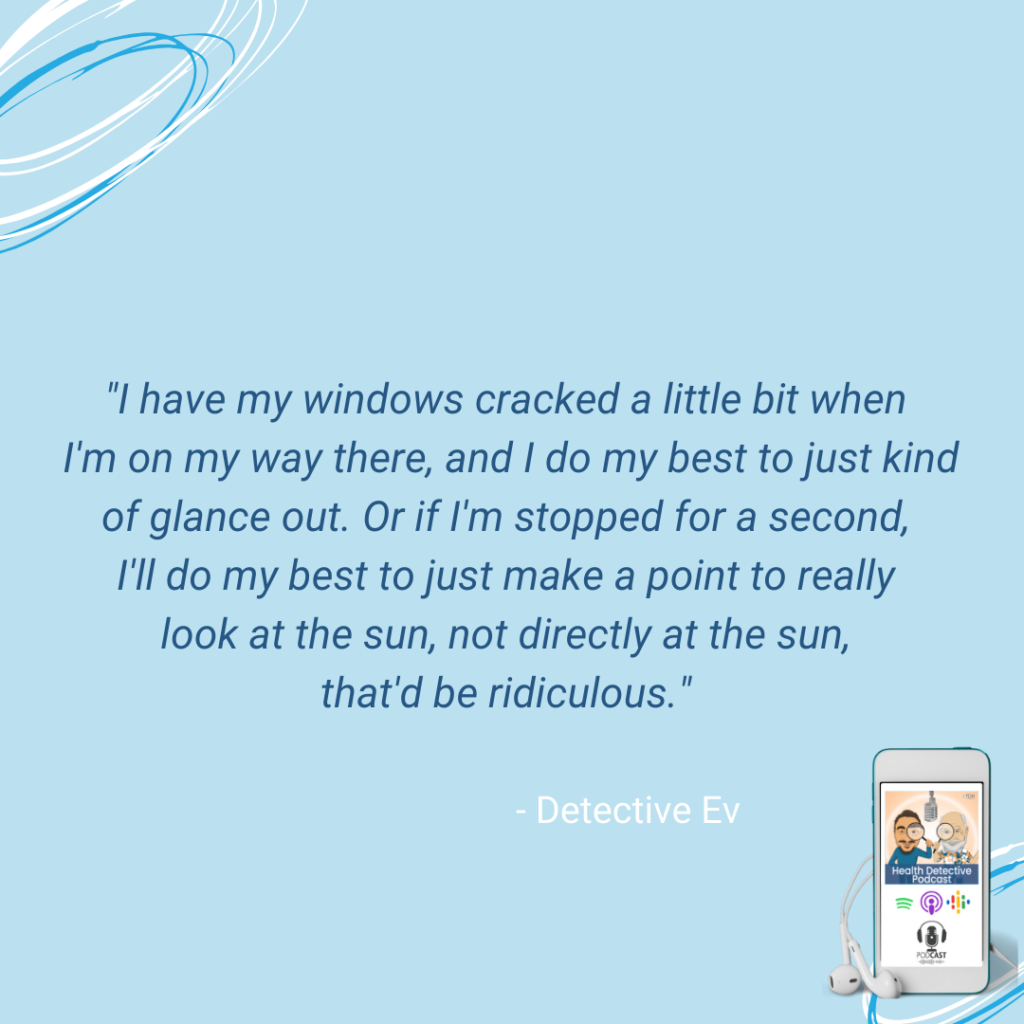
Tomorrow morning, for example, as I’m recording this, when I go to do a school, I’m going to have to be there fairly early. I have my windows cracked a little bit when I’m on my way there, and I do my best to just kind of glance out. Or if I’m stopped for a second, I’ll do my best to just make a point to really look at the sun, not directly at the sun, that’d be ridiculous. Let my body know that it is mourning.
Dealing with Light and Plunging in Cold Water
It is time to wake up. It is the beginning of the day. I’m going to need you, body, to produce melatonin for me hours and hours later in accordance with the fact that it is now mourning, right? So, we’re going to wake up now, you’re going to suppress melatonin for me, and you’re going to help me produce it later in the day.
You can kind of get away with stuff like that. I don’t think that’s going to suffice for someone, again, who is in the midst of a health journey. You won’t necessarily feel the same benefits. But for me, I’m kind of amazed how stable I can stay just by doing that. Then on the days that I’m able, always getting outside.
This might not be for you, but my girlfriend and my friends and I, we are very all into the plunging in cold water type of thing. We have a river near us, and we go there plenty of times in the morning. Not every time, but you know, we’ll go there. I mean, just today we did this.
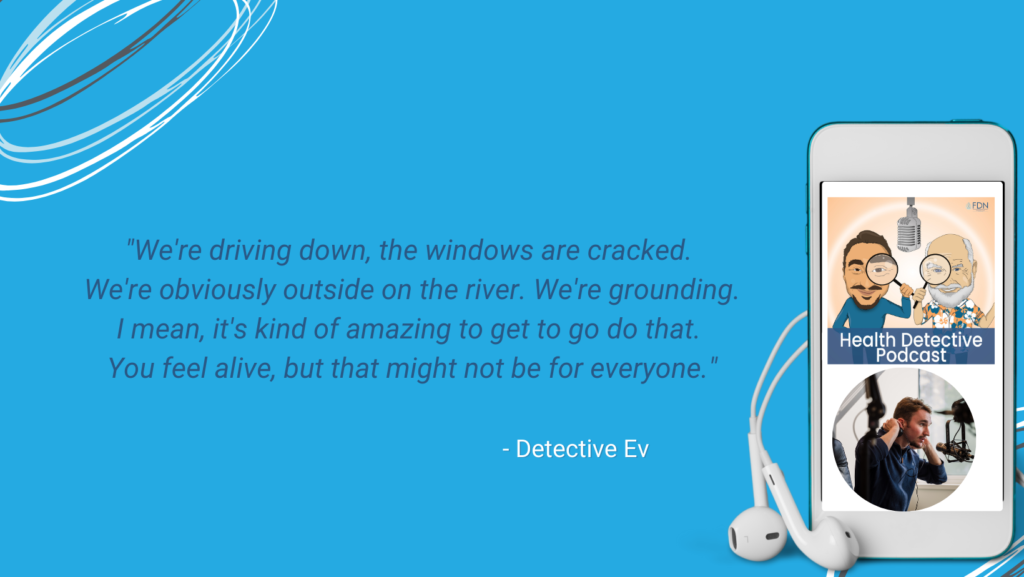
We’re driving down, the windows are cracked. We’re obviously outside on the river. We’re grounding. I mean, it’s kind of amazing to get to go do that. You feel alive, but that might not be for everyone. So, you do what you can when you can.
Dealing with Light: How Much Sunrise?
If you got a back deck, great. Sit there. If you can walk with a warm jacket, walk around. If you can only crack the windows right now, that would be a good thing to do. Opening your windows to your house. I mean, your heating bill might go through the roof, but opening the windows to your house can be another way to do this as well. The screen kind of filters light, but you’re good for the sake of this podcast.
The window itself though, does filter light, so keep that in mind. That’s not something that you want to have closed when you’re looking at it. You definitely want to go out there and do that. So, catch sunrise every single day in some way. If you could only do a couple minutes, you are better off than nothing. Just make sure your body got some opportunity to realize that it is in fact morning.
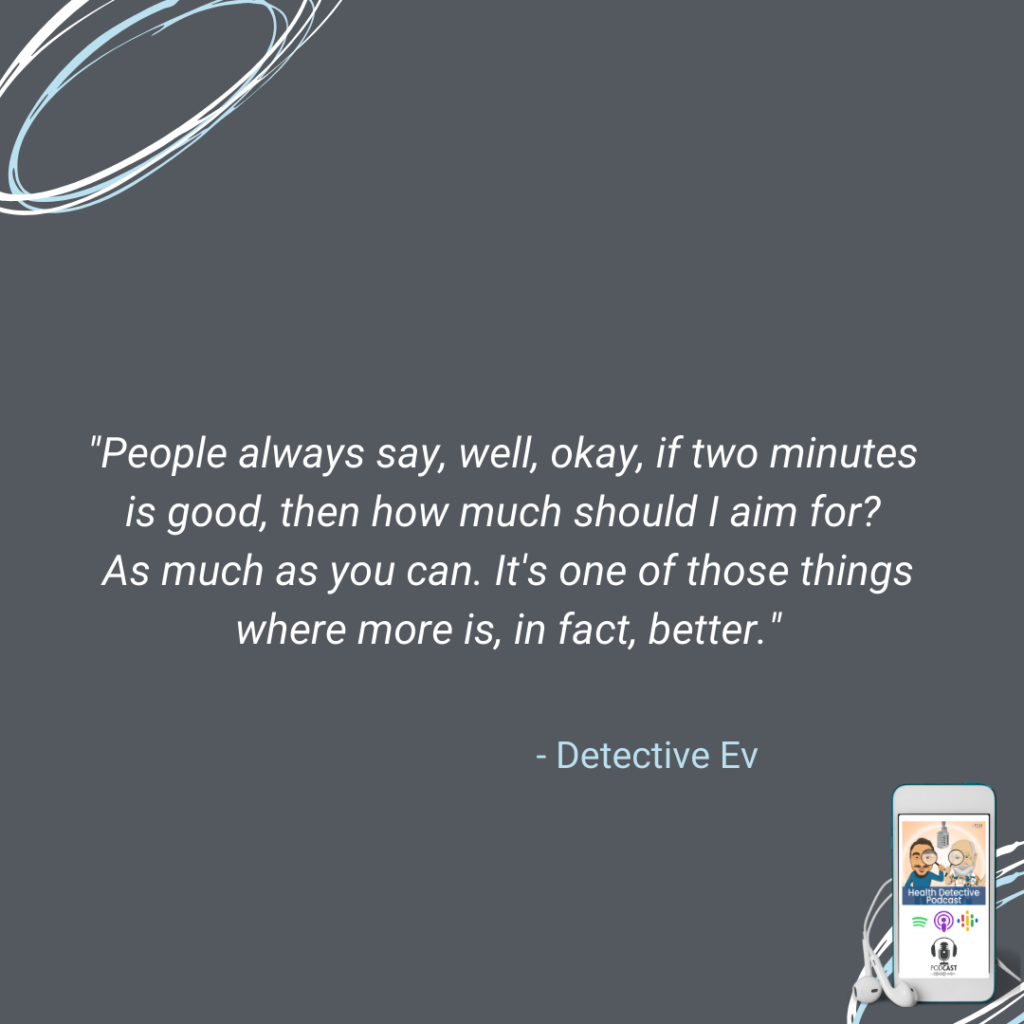
People always say, well, okay, if two minutes is good, then how much should I aim for? As much as you can. It’s one of those things where more is, in fact, better.
Water? You kind of have to find the right amount. If you drink too much water, you can end up literally drowning yourself, right? You could die from drinking too much water. Too much of a good thing is not always a good thing. With the case of light, it’s not really the same.
Now, I’m not suggesting that you sit out in summer sun and bake yourself to death and literally get all burnt up. That’s not what I’m suggesting.
Is Your Job Hindering Your Health?
But in terms of your eyes being in tune with natural light. Let’s say it was this summer, hypothetically, and you’ve already exceeded the amount of time based on your complexion that you can last out in that sun. Well, you could still be under the shade of a tree or a house or have the windows open and be exposed to that natural light without it directly hitting you. That’s what I’m talking about.
In terms of using natural light as your guiding source of light to get through the day and to see things, there is never a time where you’ve exceeded the amount of that that you should do. It is always a good idea to use that light instead of artificial lights. So minimum, minute or two, bare minimum. But ideally as much as you can and make up for it on the days that you have the ability. There’s gotta be some day or days of the week where you have the ability to do this, please take advantage of it if you can.
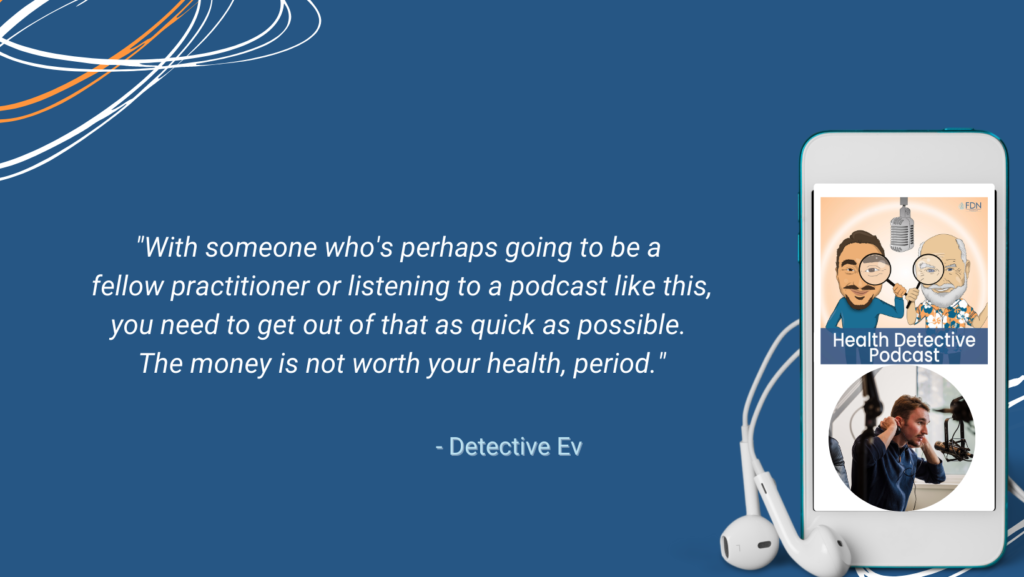
If you are working night shift, you guys know me on this one, you need to get out of that job as quick as possible. With clients, I’m a little less aggressive in that. With someone who’s perhaps going to be a fellow practitioner or listening to a podcast like this, you need to get out of that as quick as possible. The money is not worth your health, period.
Okay, so first is sunrise. The next part would be sunset. And this one isn’t necessarily one I’m super diligent with. Admittedly, I hadn’t ever been really religious with this one, and I still found great benefits. But it’s something you try to do.
Dealing with Light: Catching Sunset
What the sunset thing looks like is just making sure your body gets out at the times when it’s become dark, or the sun is starting to set.
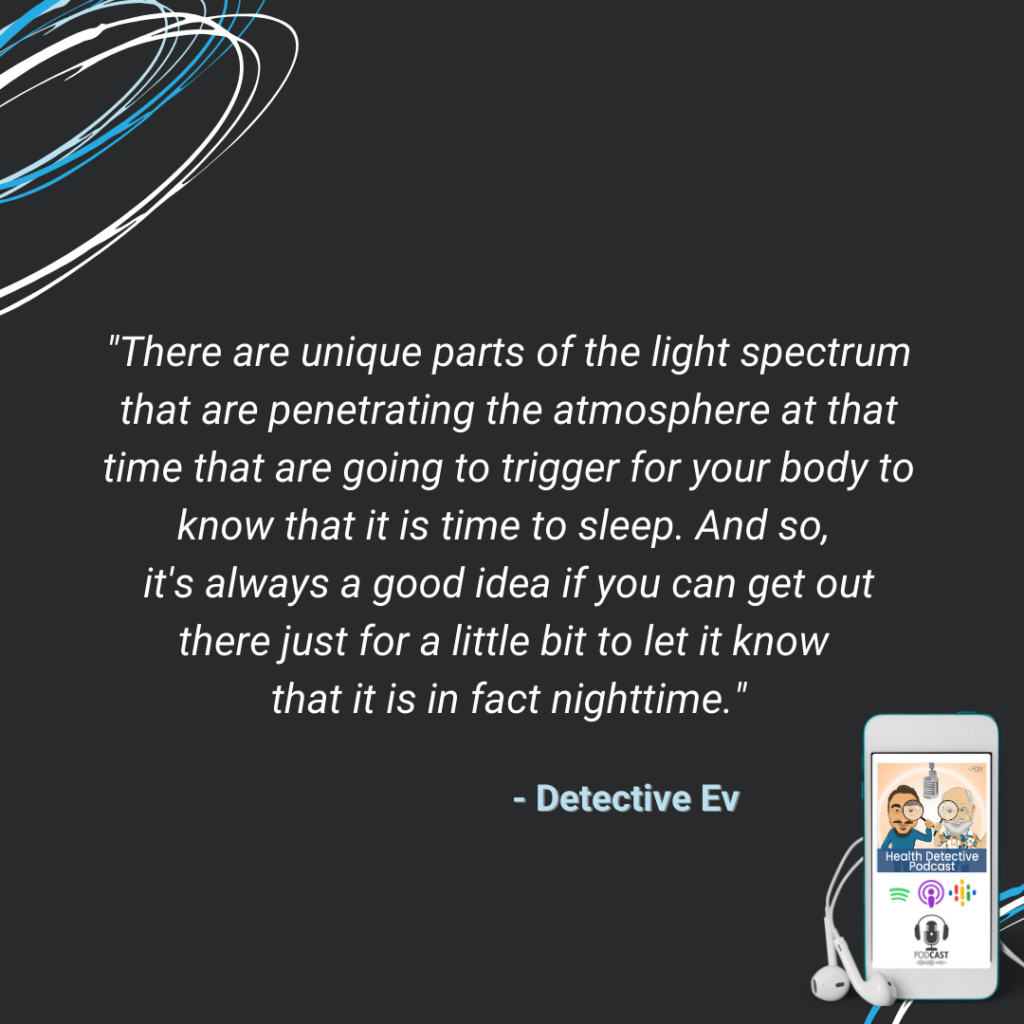
There are unique parts of the light spectrum that are penetrating the atmosphere at that time that are going to trigger for your body to know that it is time to sleep. And so, it’s always a good idea if you can get out there just for a little bit to let it know that it is in fact nighttime. That’s awesome. Then when you come back indoors, you guys already know, you use your blue blockers. Is that a perfect hack? It is not, but it’s one of the best things that we have right now.
So, at nighttime in my apartment, we have the Himalayan salt lamps. They’re pretty good, usually. Some of them are a little worse than others, but generally speaking, those have a deeper red. You could use the red-light bulbs from boncharge.com, formerly known as BLUblox.
I don’t know why we’ve been procrastinating this. We’ve been meaning to order these, so we’re going to get a few of those ourselves soon. I cannot wait to have the red bulbs in my house. But the glasses are always a good start, and then filtering the technology.
If you look up how to put a red-light filter on your phone on YouTube, it’ll come right up. Then if you buy the program, Iris, not sponsored, but Iris. I think it’s iristech.co. Search that on Google if it doesn’t work on the URL. You can actually filter your screen to make it red at night. Is it going to be as clear as when you don’t have that? No.
Dealing with Light: Preparing for Bed Using Technology
Of course, if you’re doing graphic design, that would not be the time to do graphic design. But this is a great time to, I don’t know, if you watch movies or TV shows, whatever you do. I like reading stuff. I’m like someone who will chill out at the end of the night, one or two hours with a video game if I’ve had a really long day. That’s just something that works for me.
I can play the video game, you can watch the TV or movie I’m assuming, or YouTube with the red light. It’s not as ideal as normal, but it’s something that can be done. So great, you get to be entertained and you get to do that as well.
A third option is buying a book clip light. Bon Charge, again, sells those. You can also find them on Amazon. They’re not as deep as a red as I would like, but they’re certainly better than nothing. And so now you’re really doing a good habit.
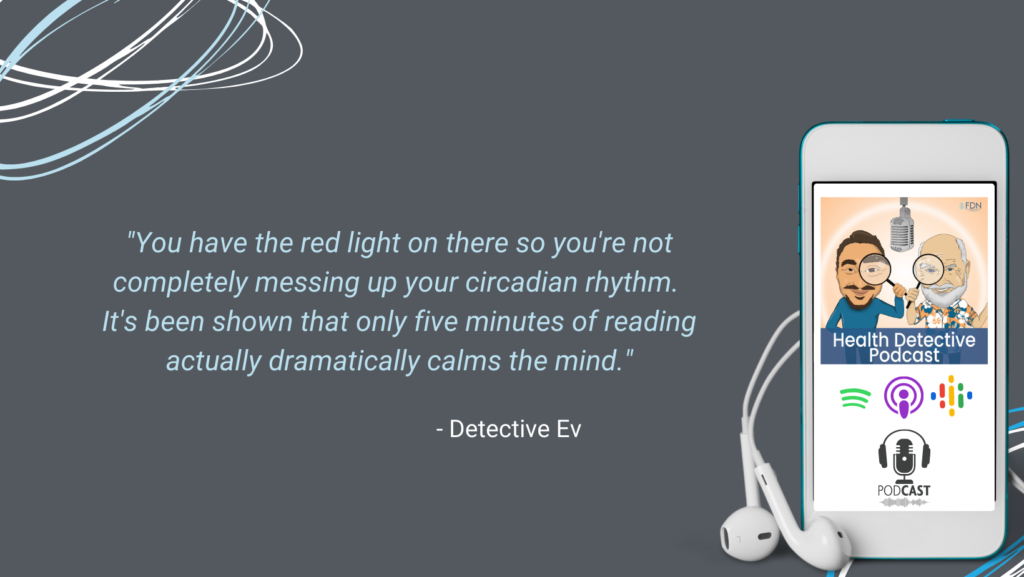
You’re reading in the nighttime; you’re reading before bed. You have the red light on there so you’re not completely messing up your circadian rhythm. It’s been shown that only five minutes of reading actually dramatically calms the mind. It’s probably a great way for most people to actually get to bed if they’re people that have trouble sleeping.
So, that’s what you gotta be careful about with this time of year. I know for most people, and I don’t even do this every day, but I did while I felt my worst. To be clear, I did this for a couple of years straight. Not everyone likes the idea of throwing the blue light blocking glasses on like the red ones right after sunset.
Dealing with Light: UVB Affects Insulin Sensitivity
I mean, for some people, sunset here right now is like five o’clock, right? So, you have probably four or five hours still a week where you gotta operate with those. I’m telling you, if you’re not feeling so good right now, if you feel sick, mental health issues, skin issues, all that stuff, I would put them on as soon as possible because that’s what really kills us this time of year.
We are completely eating wrong in terms of seasonality of food, but we’re eating sugar candy, holiday stuff, right? Stuff that should not be eaten really any time of year, let alone winter. The body is not designed to be eating high amounts of carbohydrates in winter. This is actually true, by the way.
There’s been studies showing that UV light, particularly UVB, which is only possible in high amounts in spring, summer, and fall, that actually creates insulin sensitivity, which is the good thing. Remember, you don’t want to be insulin resistant. You want to be insulin sensitive.
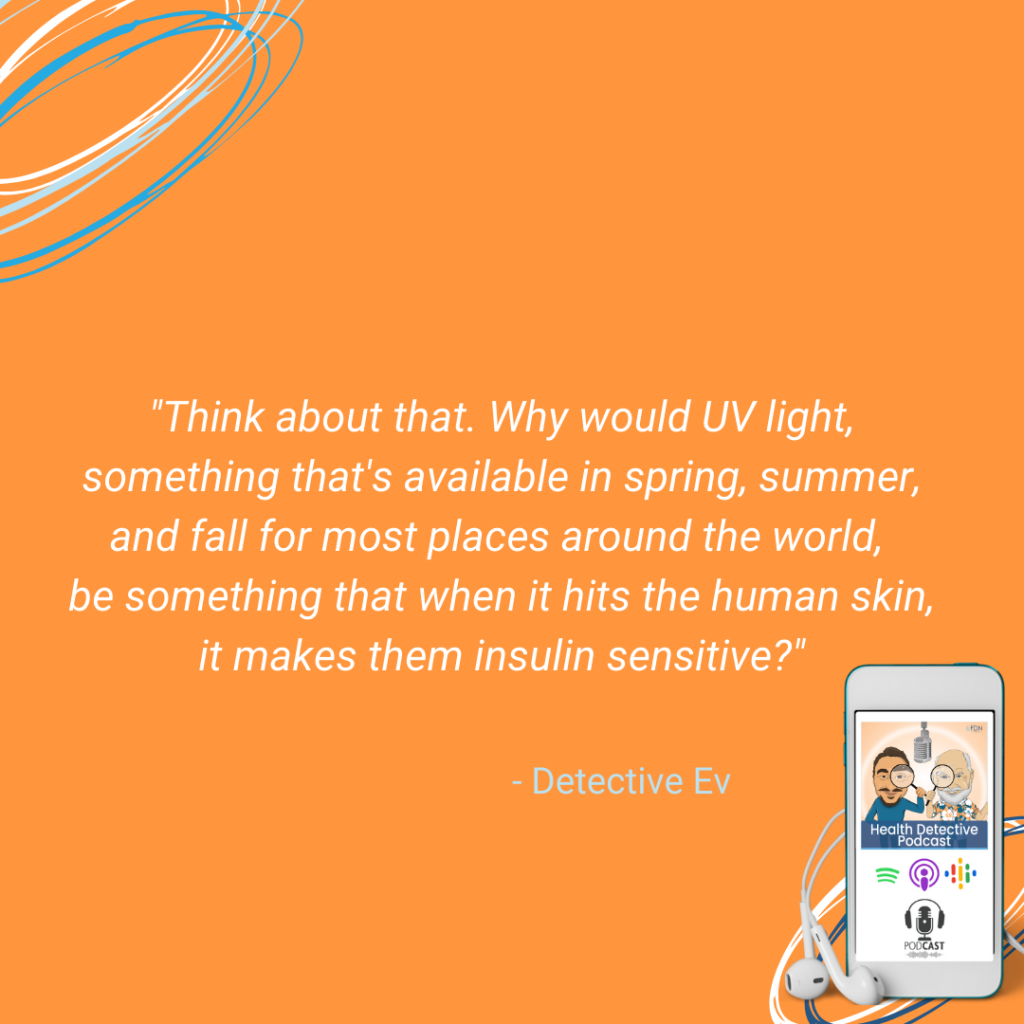
Think about that. Why would UV light, something that’s available in spring, summer, and fall for most places around the world, be something that when it hits the human skin, it makes them insulin sensitive? It’s almost as if the body knows that, oh, wait a second, the crops are going to grow in summer. I should prepare this person to eat a larger amount of carbohydrates than they would the rest of the year. Interesting, right?
Dealing with Light Using Red-Light Therapy
Going back to the original point, we’re completely eating out of season in the winter. Then on top of this, artificial light is terrible for us, and we spend 5, 6, 7 extra hours in complete artificial light because there is no light coming from outside. There is no natural light, right? So be careful.
This is not a time of year to mess around. If you are sick, there’s things that you can do. We’re talking about those today. Just make sure to be really routine with them, to feel as good as possible.
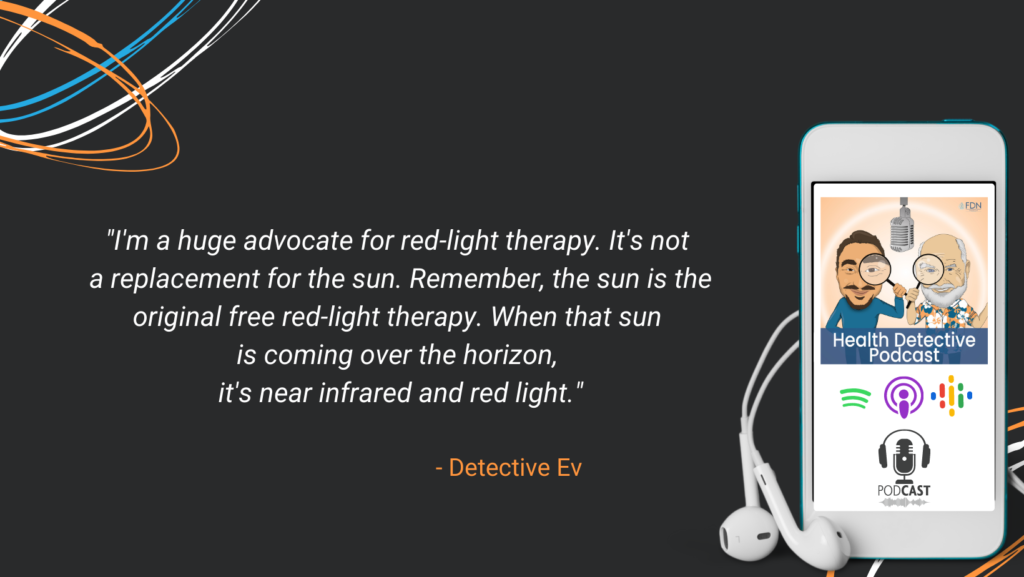
I got two other things I want to mention today. I got my little list here. One is red-light therapy. I’m a huge advocate for red-light therapy. It’s not a replacement for the sun. Remember, the sun is the original free red-light therapy. When that sun is coming over the horizon, it’s near infrared and red light. That is true all the way until the sun sets. It doesn’t matter the time of year, red and near infrared light is going to make up about 42% of sunlight. That is great.
So, free red light with all the other benefits that the sun gives us is coming out every single day and most of it penetrates the clouds by the way. That’s brilliant. There are obviously reasons and hurdles in our modern lifestyle that prevent us from getting the amount of red light that we’d probably want to get.
Dealing with Light: Red and Near Infrared Light
When human beings isolate light, we know that there are consequences to that. For example, isolating blue light has not worked out favorably for us at all. We know what it does to human beings. We’re still learning, but I mean, already it’s terrible.
We know what isolated UV light does, right? If you isolate UVA, you can get someone very tan very quick. But you could also pose a risk for skin cancer if you’re not taking other precautions. So, isolating light in general has proven to be not always beneficial.
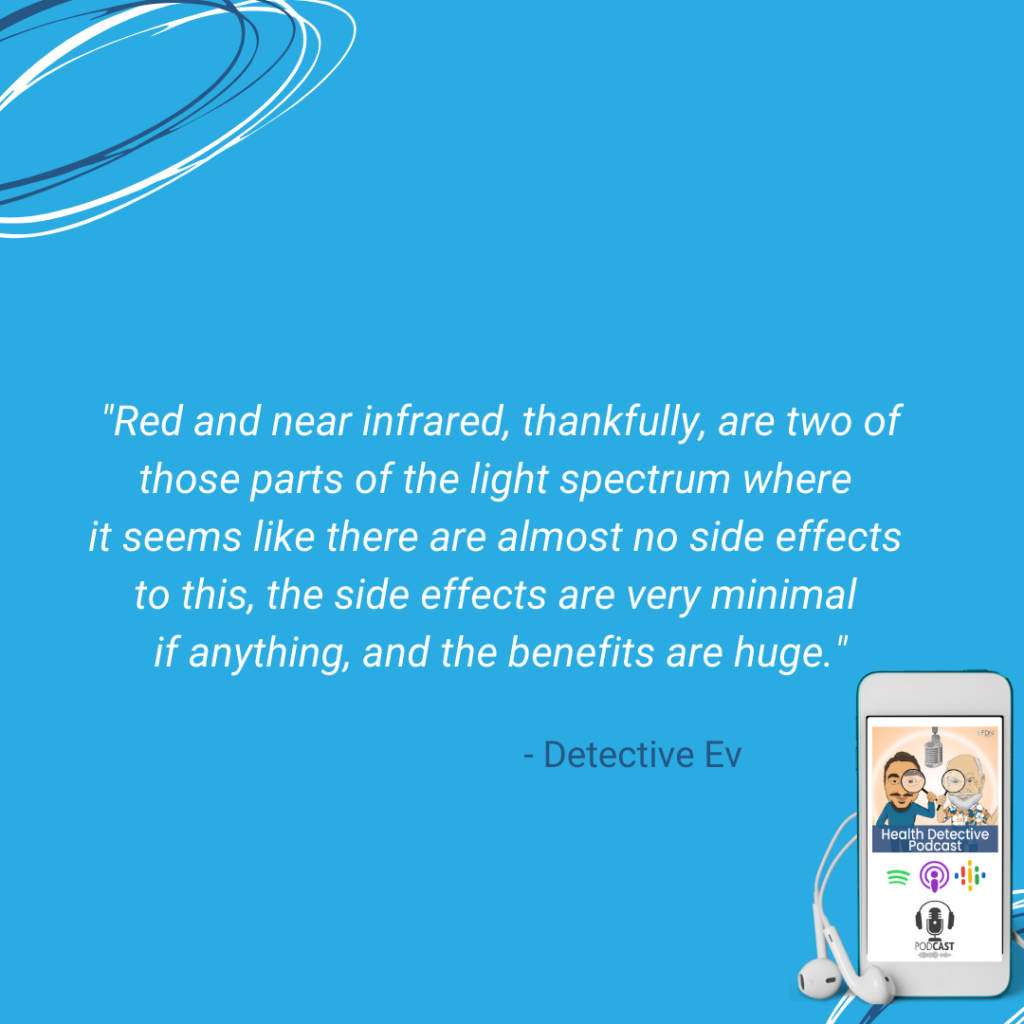
Red and near infrared, thankfully, are two of those parts of the light spectrum where it seems like there are almost no side effects to this, the side effects are very minimal if anything, and the benefits are huge. So, as long as you are doing everything that you can to get the light from the sun and you’re putting an honest effort in, I’m all for the red-light therapy.
I’m not sponsored by these people, but I do like PlatinumLED. PlatinumLED is what we use at my in-person business in Pennsylvania. We trust them. They are comparatively cheap, and they still have a greater output than a lot of the main ones on the market. I’m not going to get into the main ones on the market.
I’m not here to debate that or cause any trouble for myself. But you gotta remember, I’ve said this on the podcast before for a different reason, and I will say it today. My parents had a small restaurant when I was younger. They sold, you know, cafe stuff. There were burgers, there was lunch stuff, breakfast stuff, whatever.
Do Your Research for Quality Products
Across the street was a McDonald’s. McDonald’s, even though my parents were not health freaks by any means, no way are you going to tell me that McDonald’s did not have a worse quality burger than the ones that my parents sold across the street. Yet every single day of the week for every day that my parents were open for 14, 15 years, (well, they’re still open, but they sold the business), every single day of those 14, 15 years, McDonald’s outsold them, burger wise.
Is it because they have a better burger? Nope. We just said it wasn’t. It’s because they are better at selling the burger than my parents were. So just keep that in mind. Just because someone is good at selling something does not mean it is a superior product. It means that they are better at selling it. It could be a superior product. That’s one of the ways that you could sell something. But it’s not equivalent.
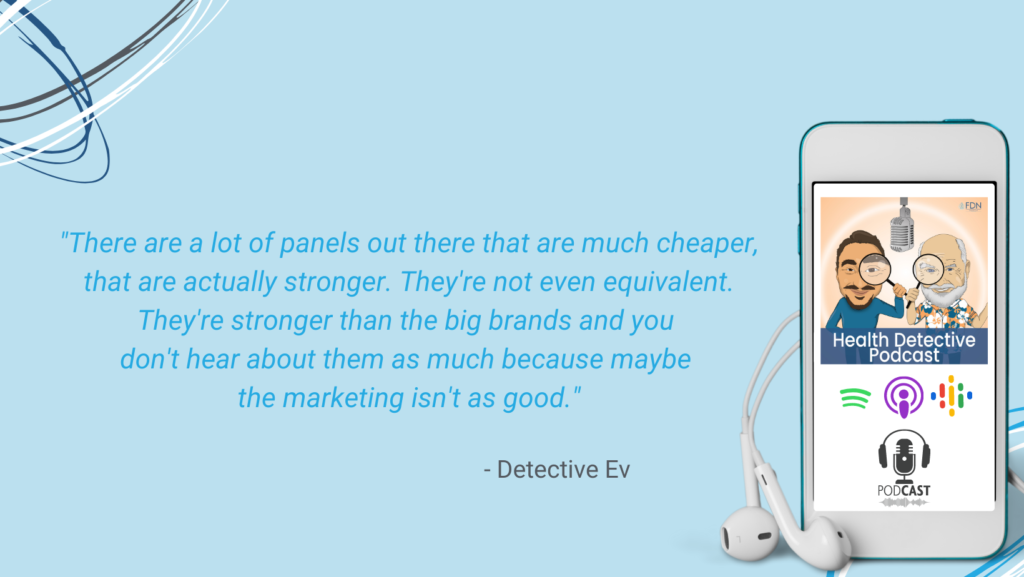
And the red-light thing, I’m not hating on any brands. I’m all for people doing whatever they can and need to do to make money ethically, but you really gotta do your research. There are a lot of panels out there that are much cheaper, that are actually stronger. They’re not even equivalent. They’re stronger than the big brands and you don’t hear about them as much because maybe the marketing isn’t as good.
So, PlatinumLED, if you guys hear this one day and want to sponsor me, I’m all for it. Let me know. But at this time, no, I’m not paid to do that. They don’t sponsor me for anything like that. We just choose to use them in our business.
Dealing with Light: Get Meaningful Amounts of UVB for Vitamin D
We’ve seen phenomenal results with this for complexion, pain, hair regrowth, or faster growth of hair. If you get a really crappy haircut, something like that, you can use the red lights for that.
Finally, I want to talk about vitamin D. We can’t talk about light without the vitamin D aspect. For many people that are living in the Northern Hemisphere right now, the issue is when you go above the 30th parallel north, there are certain times every single year where you cannot get Vitamin D.
Now it’s going to vary the closer you go to like the North Pole from that 30th parallel. And this is also true with the 30th parallel South, by the way, and the South Pole. It’s just, I’m talking about the north one right now. In the United States, it’s, I forget what it is, right off hand. If you look it up, I mean, it’s a simple thing to find.
I’m sorry, I misspoke, but I’m not going to edit that out. That’s 37th parallel North. I don’t know why I said 30th. It’s 37th parallel North. What I was confusing it with is that the sun does not go 30 degrees over the horizon when we live above or below the 37th parallel north or south respectively.
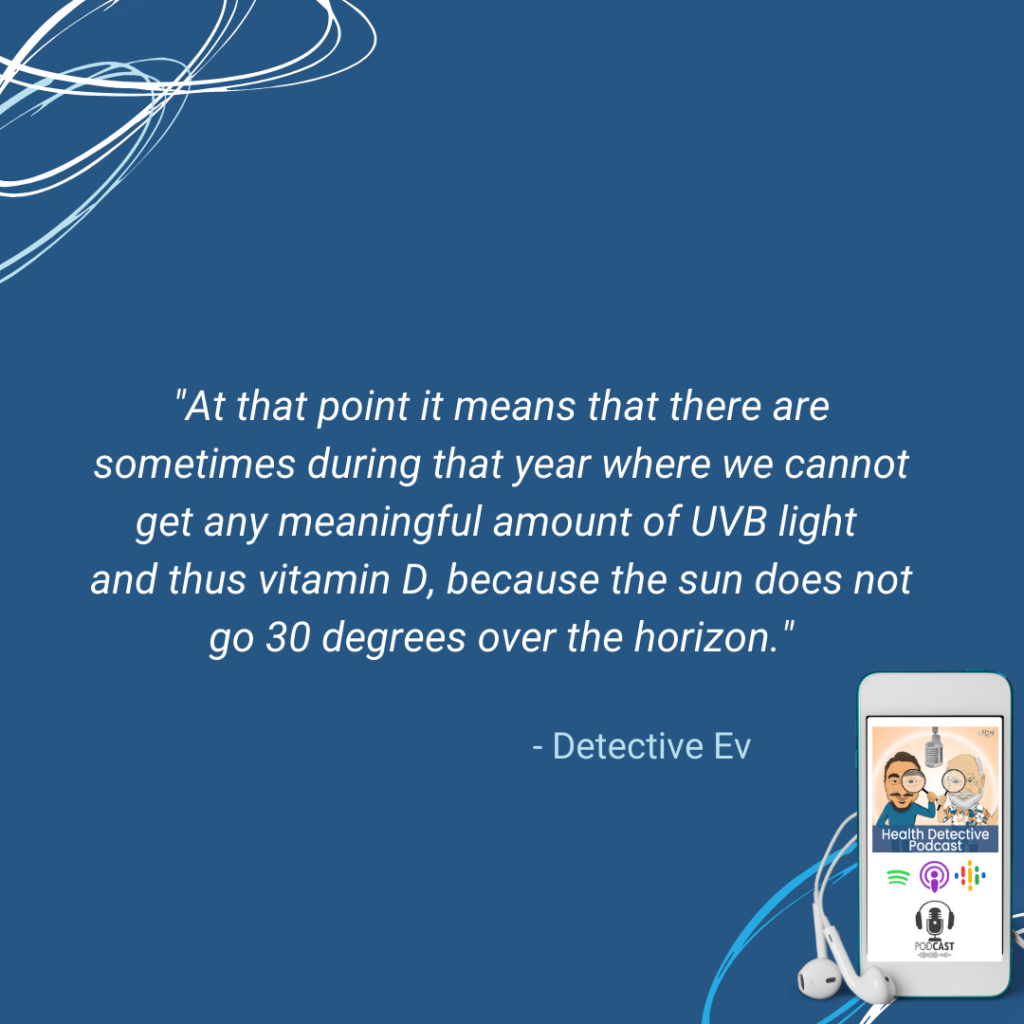
At that point it means that there are sometimes during that year where we cannot get any meaningful amount of UVB light and thus vitamin D, because the sun does not go 30 degrees over the horizon. For where I live in Pennsylvania, my window is late November. It just started for us actually a week ago, and this will last all the way until late January.
Boosting Vitamin D Up with K2
With that said, something to use common sense with, just because the window is gone from late November to late January, does not mean I’m somehow getting meaningful amounts of vitamin D in October and February. That really doesn’t make sense. In fact, the lowest month for vitamin D status in United States of America is March.
So, if it’s March, we can use common sense and say, okay. Obviously, just because the vitamin D window is back does not mean people are actually getting vitamin D. You would have to be out taking your clothes off. You’d have to be out at the right times. You’re probably working a job or you’re on a call with a client. There’s a million different reasons that you might not be getting it.
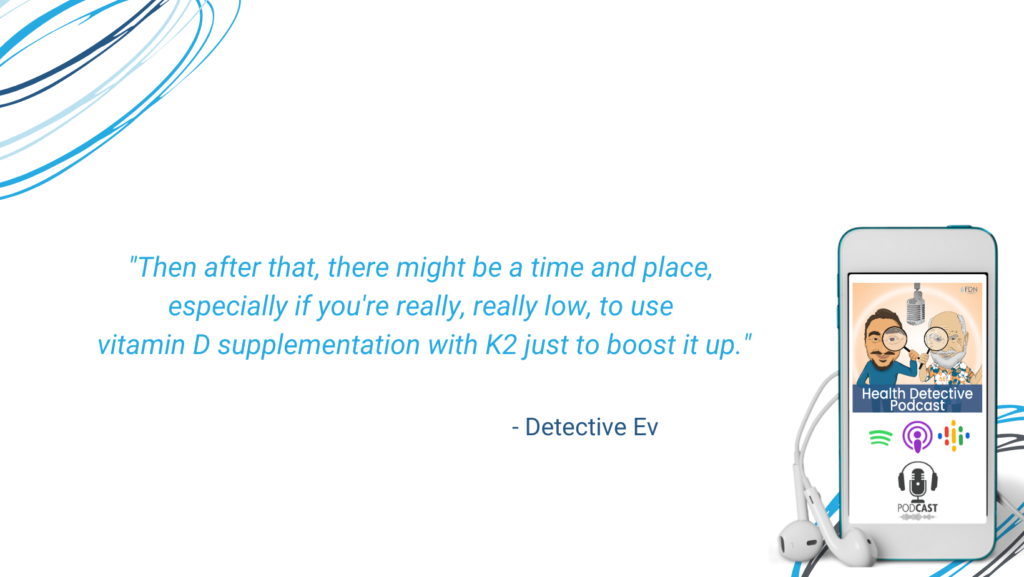
So, how I handle vitamin D in the winter is, one, go get tested. Figure out what your levels are at, that’d be a good place to start. Then after that, there might be a time and place, especially if you’re really, really low, to use vitamin D supplementation with K2 just to boost it up.
The reason you want the K2 is to avoid hypercalcemia and most people are deficient in vitamin K2 anyway. There’s been some studies showing that eight weeks of vitamin K2 supplementation increased like max VO2 output by like 12% in people. So that’s kind of cool if you’re an athlete or someone who just wants to stay fit, on a little side nerdy note there. So, definitely use the K2 anyway.
But I don’t like to get it from a supplement. Boost your levels if that’s what you gotta do, fine. Test it again. Awesome. But I prefer to get this from light and there’s a couple of reasons.
Dealing with Light: Making Vitamin D
One is just common sense. Because I could get, for example, 15,000 IU of vitamin D from the sun every single day, and I’m assuming I’m not supplementing. I could get that from the sun every single day and I would never overdose on vitamin D.
Well, it’s not that you overdose literally on vitamin D, but I would never become hypercalcemic, which is technically what happens when you quote/unquote “overdose on vitamin D”. But if I took 15,000 IU of vitamin D every single day as a supplement and did not take it with K2, because K2 actually helps you get the calcium where it needs to go, as opposed to just stacking up in your blood, hypercalcemia, then in theory, I mean, I could potentially get hurt from this or even die from this.
I think that immediately shows you the difference in how the body handles this. So, if I supplement with it, the exact same amount that I could get from the sun, I need to take extra nutrients to make sure I don’t become hypercalcemic. Yet when I get it from the sun, the body knows how to work with that so easily that I don’t need any of those extra nutrients. Just something to think about.
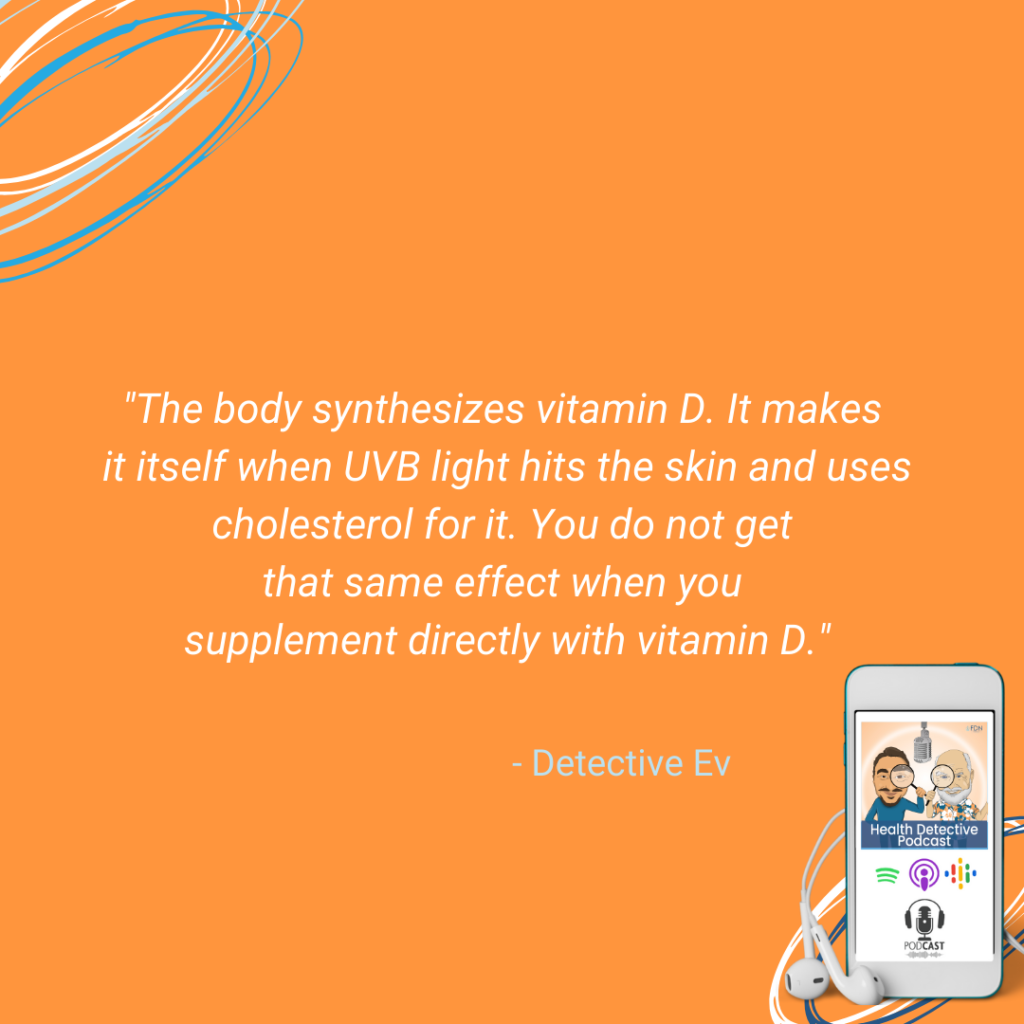
The other thing is too, when you are using supplemental vitamin D as opposed to sunlight derived vitamin D, you’re not utilizing cholesterol in the way that you are supposed to. The body synthesizes vitamin D. It makes it itself when UVB light hits the skin and uses cholesterol for it. You do not get that same effect when you supplement directly with vitamin D.
Dealing with Light Using a Vitamin D Lamp
It makes you wonder, do people actually have a cholesterol problem in this country and countries around the world, or do we have a light deficiency problem? Just something to think about. Those are the main things I would worry about.
And then in terms of getting the vitamin D itself, it’s like, well, how do I do this Ev, if there’s no vitamin D window? Again, not sponsored, but if they ever hear this, I’m happy to take a commission. I would get a Sperti Vitamin D lamp. They’re not cheap, but they’re affordable. It’s something that’ll last you a long time.
The machine’s not going to go anywhere unless you like throw it across the room and you shouldn’t be doing that. The only thing you’d ever need to replace is the bulbs. So, it’s a very good investment, in my opinion. It could be a good investment even for rainy days in the summer when you can’t get out. Just get a little extra dose what, three-to-five-minute treatments even if you’re someone who has very dark skin.
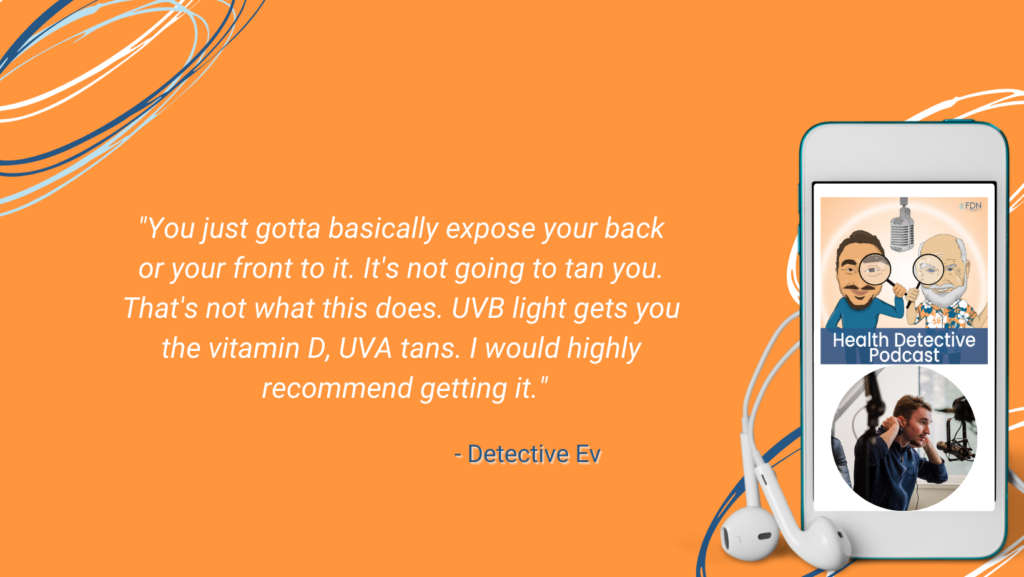
I mean, you’re talking about something that’s insanely quick, easy to do, not inconvenient at all. You just gotta basically expose your back or your front to it. It’s not going to tan you. That’s not what this does. UVB light gets you the vitamin D, UVA tans. I would highly recommend getting it.
Summary for Dealing with Light
In summary, we want to make sure in this winter and every winter that we are catching as much sunrise as possible for as long as possible. But Ev, it’s cold. Okay. There are jackets for people who go to sub-50-degree weather. You can find a jacket to handle your 20-degree winter day. You’re going to be fine; I promise you. Catch sunrise as much as possible.
Do the sunset thing as much as you can. At the very least, get out just for a few minutes and then put those blue light blocking glasses on so that your body understands that it’s nighttime.
Utilize Iris, utilize Himalayan salt lamps. Utilize the things from Bon Charge and get the bulbs there, the reading lamps that’s really cool. Then you can just read and have the red light. Make sure that you are utilizing some type of red-light therapy, PlatinumLED. I love those guys. I would definitely recommend looking into their panels. Then finally, last, but certainly not least, is using a vitamin D lamp such as the one offered by Sperti.
If you really want a pro-tip here, I recommend using the red-light therapy after using the UV light because UV does damage our skin to some degree, especially if we do it in excess. Red light and near infrared light have been shown to repair that skin.
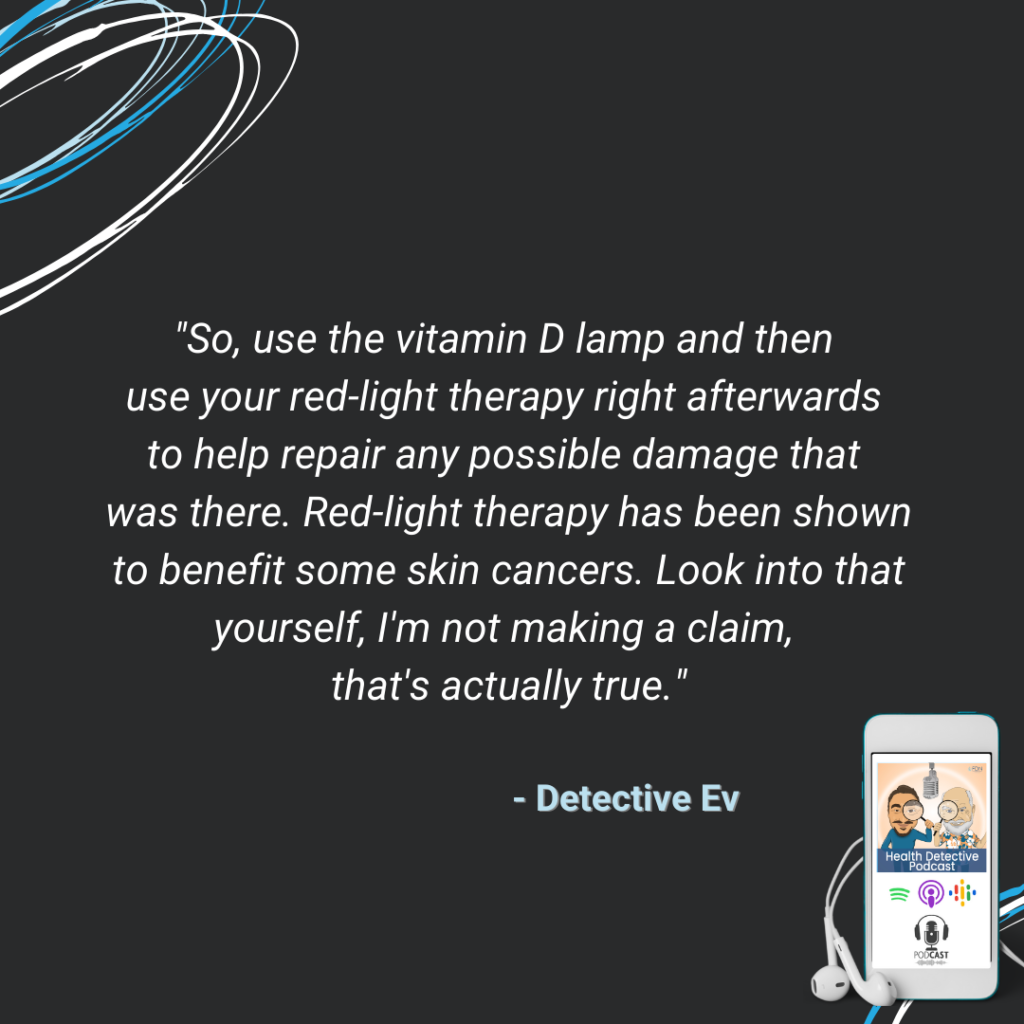
So, use the vitamin D lamp and then use your red-light therapy right afterwards to help repair any possible damage that was there. Red-light therapy has been shown to benefit some skin cancers. Look into that yourself, I’m not making a claim, that’s actually true. So that would be my pro-tip is use one and then the other.
Conclusion
With that all said, I hope you guys appreciate this short and sweet episode. Try to have a healthy winter. Be smart about what you’re doing, all right? I’m sure I’ll have some more episodes coming up with additional tips for this time of year regarding diet supplementation, different things like that. But here is the light side of things, if nothing else.
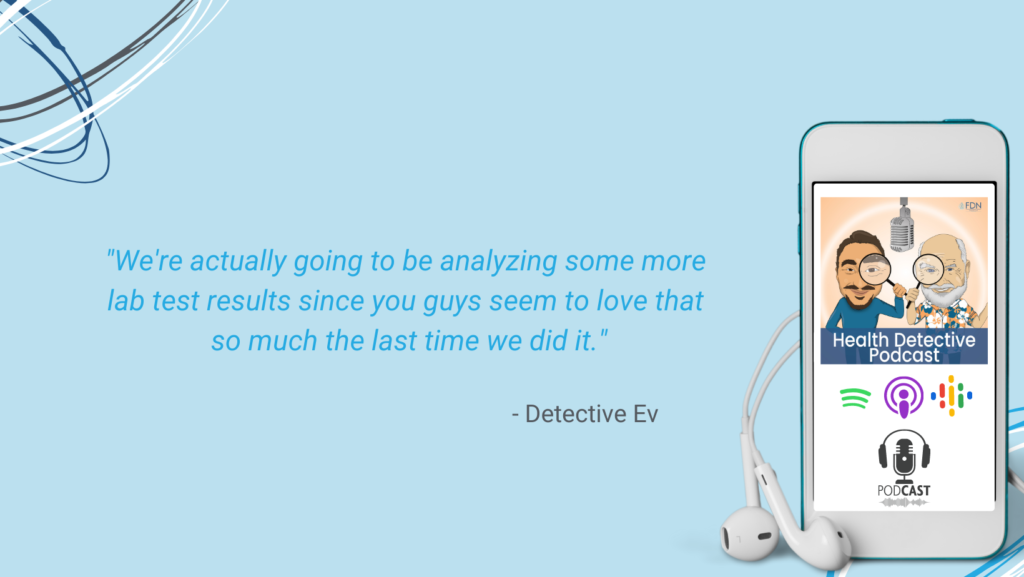
I will be back next time with a cool interview. We’re actually going to be analyzing some more lab test results since you guys seem to love that so much the last time we did it. This time we will be analyzing my poop. I’m sure you guys can’t wait for that. Have a good week and I will talk to you guys again soon.
You can always visit us at functionaldiagnosticnutrition.com.
To hire a coach, go to fdnthrive.com.
For a FREE Health Review, go to fdnthrive.com/match/.

